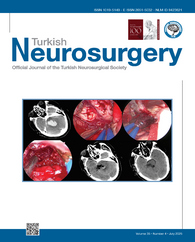2Ankara University, Faculty of Medicine, Department of Neurosurgery, Ankara, Türkiye
3Pamukkale University, Faculty of Medicine, Department of Neurosurgery, Denizli, Türkiye
4University of Miami, Miller School of Medicine, Department of Neurological Surgery, Miami, Florida, USA
5Gaziantep University, Faculty of Medicine, Term V Student, Gaziantep, Türkiye
6Gaziantep University, Faculty of Medicine, Department of Anatomy, Gaziantep, Türkiye DOI : 10.5137/1019-5149.JTN.46851-24.3 AIM: To compare the sphenoid ridge (SR) morphology in patients with Chiari type I malformation (CIM) with healthy subjects.
MATERIAL and METHODS: Three dimensional (3D) computed tomography scans of 49 (25 men / 24 women) CIM patients aged 45.84±18.04 years, and 52 (26 men / 26 women) healthy subjects aged 43.46±11.62 years were included in the investigation. The angulation and dimension of SR were measured for both groups.
RESULTS: Compared with the controls, CIM patients had greater lesser wing (LW) length (p<0.001) and LW width in the midline (p<0.001), but shorter LW width in the midpoint (p=0.001), LW width in the lateral point (p<0.001), and LW angle (p<0.001). In CIM, two configurations regarding LW angle types were observed: Type B in 75 LWs (76.5%) and Type C in 23 LWs (23.5%). In controls, two configurations regarding LW angle types were observed: Type A in 35 LWs (33.7%) and Type B in 69 LWs (66.3%). The distribution of the types according to study groups demonstrated that CIM affected significantly LW angle types (p<0.001).
CONCLUSION: LW angle and length may represent middle fossa depth and anterior fossa width, respectively; thus, CIM subjects possess shallow middle fossa and wider anterior fossa.
Keywords : Chiari type I malformation, Sphenoid bone, Sphenoid ridge, Lesser wing, Computed tomography




